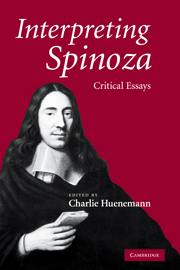Book contents
- Frontmatter
- Contents
- Notes on contributors
- Method of citation
- Introduction
- Chapter 1 Representation and consciousness in Spinoza's naturalistic theory of the imagination
- Chapter 2 Rationalism run amok: representation and the reality of emotions in Spinoza
- Chapter 3 “Whatever is, is in God”: substance and things in Spinoza's metaphysics
- Chapter 4 Necessitarianism in Spinoza and Leibniz
- Chapter 5 Epistemic autonomy in Spinoza
- Chapter 6 Spinoza and the philosophy of history
- Chapter 7 Democracy and the good life in Spinoza's philosophy
- Chapter 8 Spinoza's unstable politics of freedom
- Chapter 9 Should Spinoza have published his philosophy?
- Bibliography
- Index
Introduction
Published online by Cambridge University Press: 22 September 2009
- Frontmatter
- Contents
- Notes on contributors
- Method of citation
- Introduction
- Chapter 1 Representation and consciousness in Spinoza's naturalistic theory of the imagination
- Chapter 2 Rationalism run amok: representation and the reality of emotions in Spinoza
- Chapter 3 “Whatever is, is in God”: substance and things in Spinoza's metaphysics
- Chapter 4 Necessitarianism in Spinoza and Leibniz
- Chapter 5 Epistemic autonomy in Spinoza
- Chapter 6 Spinoza and the philosophy of history
- Chapter 7 Democracy and the good life in Spinoza's philosophy
- Chapter 8 Spinoza's unstable politics of freedom
- Chapter 9 Should Spinoza have published his philosophy?
- Bibliography
- Index
Summary
Spinoza selected a seal for his correspondence that was both clever and fitting. It was a design with his initials, a stemmed rose, and the word “Caute,” or: with caution. We might suppose that he took this as a motto for himself, to act always with caution; but since his own name connoted the rose (espina is Spanish for “thorn”), it is more likely that he was advising his correspondents to handle him with caution. He had fascinating visions to offer – but beware the thorns! And his readers soon were pricked by them, as they discovered that Spinoza denied many things thought to be necessary for a civil life: free will, the traditional distinction between good and evil, heaven and hell, and the existence of a benevolent creator. Spinoza became known as an impious atheist, and philosophers over the next two centuries were both attracted and stung by what he wrote.
Philosophers in more recent times have found Spinoza to be thorny as well, perhaps not so much because of his heretical views, but because of the sheer difficulty of his great work, the Ethics. It seems that, in his attempt to lay out his thought as clearly as possible, with sharp definitions, axioms, and demonstrations, Spinoza made his philosophy well-nigh ungraspable. It is not at all unusual to hear a well-intentioned reader despair, “I know there is something powerful in there, but I can't quite get hold of it.”
- Type
- Chapter
- Information
- Interpreting SpinozaCritical Essays, pp. 1 - 3Publisher: Cambridge University PressPrint publication year: 2008



